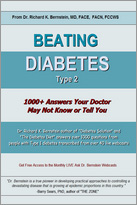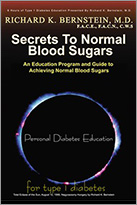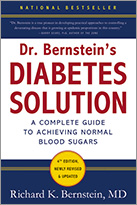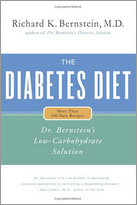The low carbohydrate/low insulin regimen – personal experience in type 1 diabetes.
Copyright © 2003 Ron Raab
In this article, I describe my before and after experience in adopting a low carbohydrate/low insulin/moderate protein/appropriate fat approach to the management of my type 1 diabetes. The Diabetes Centre in New York specialises in this approach and this article is based on what I learnt there and have applied since June 1998. I outline the rationale for and advantages of this approach and the contradictions inherent in the high carbohydrate/high insulin approach. These are my personal views and do not represent the position of organisations with which I work.
I was diagnosed with type 1 diabetes in 1957 at the age of six years, and started on one insulin injection daily increasing to two each day in 1959. In 1984 this increased to three injections daily and since 1994 to four each day. I started self-blood glucose testing in 1980, and of course before that I was testing urine. I now test four times each day (using a plasma calibrated meter) and I also do moderate exercise two to three times per week.
I have had some background retinopathy and some neuropathy, including some delayed stomach emptying. This was worsening before I adopted this new regimen and was concerning me greatly. I tried my best to get really good blood glucose levels and applied the current Diabetes Association and professional medical, diabetes ducators and dietitians high carbohydrate, low glycaemic advice. But I could not achieve continuously near normal glucose levels and was having more and more severe hypos as a result as well. The current advice did not work.
Low carbohydrate food plan In 1998, through the many contacts I had made, I became aware of another approach – the low carbohydrate, low glycaemic index food plan together with much lower insulin doses and a choice of protein intake. I also visited a diabetes center in New York that specialises in this. Its Director Dr Richard Bernstein has had type 1 diabetes for over 50 years. He adopted this food plan many years ago after a lot of experimentation and reported that his diabetes control dramatically improved. I was also interested in this approach, as I had observed over many years that when my carbohydrate intake was lower, my blood sugar improved. This further encouraged me to try this very different food plan, while remaining sceptical and looking for results. I was intrigued by reports of normal HbA1cs in Dr Bernstein’s book1 and internet site https://www.diabetes-book.com, news reports and from personal accounts. The low carbohydrate diet was and continues to be discussed a lot in the USA and elsewhere and there is increasing discussion in diabetes journals and at conferences.
I experimented a lot and, since July 1998, have reduced my total daily carbohydrate intake from 200 grams then to 30–50 grams daily in 2000, all of a slowly absorbed type. I do not regard this food plan as ‘radical’ or a ‘fad’, and should not be confused with more extreme food plans such as high protein or high saturated fat diets.
My insulin dose has fallen by 55% to 16 units daily. My HbA1c has fallen by 33% to 5.6% and continues to improve. There is much less variation in my daily blood glucose levels. Hypoglycemia is much less severe, and require only 3–5 grams of glucose tablets to ease the level back up. There are no more dramatic swings and ‘time-out’ is no longer needed for recovery, unlike with the high carbohydrate/high insulin regimen.
My weight has dropped from 84kg to 72kg with body mass index in the normal range; retinopathy has stabilised; blood pressure remains normal and lipids are in the normal/acceptable range and have remained so for most of the period of four years since I started this regimen, with the focus being on not over-consuming the ‘wrong’ type of fats. The weight loss was accompanied by some urine ketones but this has not been an issue since and is different to ketoacidosis due to lack of insulin, for example.
Importantly, my hunger has decreased (insulin is an appetite stimulant and this regimen has resulted in lower levels of insulin). I have more motivation, less frustration and my subjective quality of life and outlook have improved enormously. I also continue with regular mild exercise.
Lowering daily carbohydrate intake makes sense on many levels. Why eat so much of a food type that is at the root of blood glucose instability and which requires more insulin in response, which in turn creates further problems. There is no evidence supporting high carbohydrate intake over lower intake in terms of blood glucose control, yet this is what is being generally advocated and promoted. Also kidney disease seems to occur subsequent to high blood glucose rather than higher protein intake, according to professionals such as Dr Bernstein and his expert colleagues. The general principles also apply to type 2 diabetes.
The greater the intake of carbohydrate, the greater the potential for unpredictability in the timing and size of the resultant increase in blood glucose. This is like adding more petrol to a fire that you cannot control! We also know that insulin absorption is variable, both between different injection sites and at different times. This variability also increases as the quantity of insulin injected increases. It therefore follows that a high carbohydrate
and concomitant high insulin regimen must result in more erratic and unpredictable blood glucose profiles, compared to a low carbohydrate and appropriately matched low insulin regimen.
Surprisingly, this is implicit in the Medical Nutrition Therapy advice of the American Diabetes Association (ADA), the nutritional advice of Diabetes Australia and many other organisations. The ADA states that starchy (carbohydrate) foods will raise the blood glucose concentration and the increase will depend on the rate and ompleteness of digestion of the starch in a food, which is influenced by many factors. This clearly implies that the more starchy foods that are eaten at a meal, the greater the potential variability in blood glucose as a result. However, rather than logically recommending a lower carbohydrate intake, the advice is the opposite and ecommends a high intake – up to 60% of calories from carbohydrate, which can mean up to 300 grams of carbohydrate per day in some individuals.
Diabetes Australia provides similar recommendations. Additionally, significant errors result from a ‘high’ arbohydrate meal. For example, a 20% variation (say 20 grams carbohydrate) in a meal is greater in absolute carbohdyrate than is recommended to treat a hypo. This does not occur in the case of a low carbohydrate meal because a 20% variation equals only a few grams of carbohydrate.
Delayed or variable stomach emptying (gastroparesis), which occurs as a result of impaired vagus nerve function (another form of diabetic nerve disease), further adds to variable and unpredictable blood glucose levels. The medical literature indicates that it occurs in 50% of patients with both type 1 and type 2 diabetes. This also contributes to greater blood glucose variability with higher carbohydrate intake.
Large amounts of carbohydrate can remain in the stomach for variable periods of time, and then unpredictably, and possibly very suddenly, are ‘processed’ or ‘emptied’ resulting in a rapid increase in blood glucose. Gastroparesis can also increase the risk of hypos if a large amount of insulin is injected in response to a high carbohydrate meal and the carbohydrate remains in the stomach.
There is also continuing evidence of a relationship between ‘high’ insulin doses (which are implicit in the high carbohydrate regimen) and the development of vascular disease, including heart disease, independent of any other factor. There is also increasing evidence of the damage that brief increases in blood sugar following meals can do in terms of the development of diabetes complications.
Therefore, even if a patient’s HbA1c level is considered to be reasonably good, a high carbohydrate/high insulin regimen inevitably produces greater swings in blood sugar than a low carbohydrate/low insulin regimen, and further contributes to diabetes complications.
Just one example of a satisfying meal that contains 12 grams of carbohydrate and 120 grams of protein is:
• Soup made from stock
• Garden salad
• Medium-sized portion of steak, fish or vegetable protein
• Cooked vegetables (no potatoes or pasta)
• Coffee with a small amount of milk.
I have consulted with the chief of the Metabolic and Obesity Research Laboratory and Professor of Medicine and Biochemistry at Boston Medical Centre, USA. She saw no basis for concern with the proportions and nature of the low carbohydrate, moderate protein, moderate fat regimen that underpins this approach. It is simple to design such a regimen to be nutritionally complete.
I have learned from such experts that protein and fat are essential nutrients, while carbohydrate is not. The body makes some carbohydrate from protein, particularly when carbohydrate from external food sources is low or non-existent. The body manufactures such carbohydrate slowly, making it a low-glycaemic index form of arbohydrate, matching the profile of regular insulin. About 10% of the ‘real’ or net protein of a food is converted in
this way. There are no nutrients in high-carbohydrate foods that cannot be derived from other sources, for example vitamins and minerals that occur in fruit also occur in foods such as salads and vegetables. In any case, the regimen described in this article is a ‘low carbohydrate’, and not a ‘no-carbohydrate’, regimen.
I have been invited to give my personal experience with this regimen at a number of professional health care meetings and diabetes associations in Australia, England and Japan. I made a presentation at the Australian Diabetes Society/Australian Diabetes Educators Association Annual Scientific Meeting in August 2000 at the symposium “Carbohydrate – More or Less?”. Following this presentation, my local physician, Dr Richard Arnott, made a number of comments to the participants, including that ‘the improvement in Ron’s HbA1c has been dramatic… his previously severe hypoglycemia has abated… lipids remain in the acceptable range… there is a call for further studies… it is perhaps time to challenge the accepted dogmas…’ Professor Paul Moffitt, a diabetes specialist honoured for his contribution to diabetes care by the Australian government, wrote to me following my presentation that: ‘I very definitely believe in a low carbohydrate diet and have done so for many years.’
A common response to this approach is that it is too extreme or difficult for the ‘average’ person to adopt. That is what I thought when I first came across it, yet having gone through the lifestyle change I am now marvellously happy with it and the results. Many may not want to reduce their total daily carbohydrate to 30 grams, which is the level needed to result in effectively normal blood sugars, but any significant move in this directon, say to 20 grams per meal (even if taking four meals daily) will result in major improvements if the insulin regimen is also tailored to it properly.
I am grateful to Dr Bernstein and colleagues who brought this approach to my attention.
Ron Raab
BEC President, Insulin For Life Incorporated, Australia
Insulin For Life Incorporated (https://go.to/insulinforlife) was established in 1999, following my work at the International Diabetes Institute in Melbourne, Australia for 20 years.




